Kombucha is sweetened tea that has been fermented by a culture; a symbiotic colony of bacteria and yeast – a.k.a SCOBY or “mother”. Despite its foreign (and somewhat off-putting) appearance, this colony of bacteria and yeast transforms sweetened tea into a tangy health elixir naturally rich in vitamins, minerals, enzymes and probiotics. Although sugar is used in the making of Kombucha, the end product has virtually no sugar content because it serves as food for the bacteria and fermentation process.
This ancient tradition of fermenting sweetened tea is believed to have many health benefits, one of which is improved digestion as a result of the naturally occurring probiotics. Probiotics provide your gut with healthy bacteria, helping to improve digestion by decreasing inflammation and increasing nutrient absorption.
Dr Axe shares his thoughts on Kombucha
Research suggests that inflammation plays a significant role on bone turnover and therefore contributes to osteoporosis.¹ Studies indicate that the factors involved with inflammation are directly linked with the critical factors of bone remodeling.¹ In short, inflammation increases osteoclast activity, the cells that dissolve bone thereby increasing your risk of osteoporosis. Furthermore, inflammation in the gut reduces absorption which deprives your body of the nutrients you need to maintain healthy, strong bones.
While most of the beneficial effects of Kombucha have been studied in experimental models only, Kombucha drinkers around the world testify some of the benefits of the tea include:²
- Reduce cholesterol level
- Reduce atherosclerosis
- Reduce blood pressure
- Reduce inflammatory problems
- Alleviate arthritis, rheumatism, and gout symptoms
- Promote liver function and detoxify the blood
- Normalize intestinal activity, balance intestinal flora
- Regulate appetite, protect against diabetes
- Stimulate glandular systems
- Enhance the immune system
- Improve hair, skin and nail health
- Reduce stress and nervous disturbances
- Improve eyesight
- Counteract aging
- Enhance metabolism
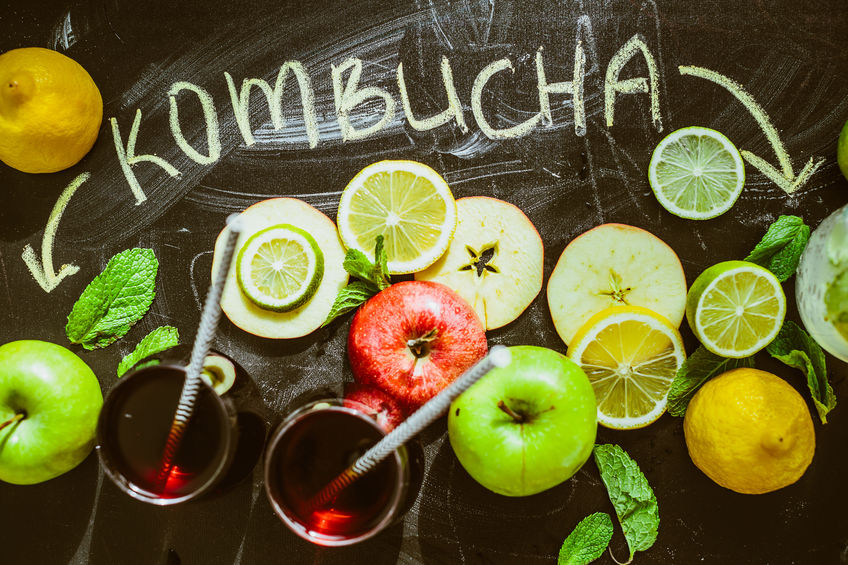
Kombucha is naturally rich in glucosamines which increase synovial hyaluronic acid production and aids in the preservation of cartilage structure.³ In addition to reduced inflammation, supporting the cartilage structure with glucosamines is a natural way to reduce arthritic pain.
One of Kombucha’s greatest benefits is the ability to detox the body, it is important to drink only a small amount when you first start and to drink more water throughout the day.⁴ As a result of the added beneficial bacteria and the dislodging of toxins in your bloodstream, temporary effects such as gas, stomach-ache, fatigue, rashes, diarrhea and headaches may occur. Drinking additional filtered water helps to excrete these toxins as quickly as possible.
It doesn’t take much to experience the many health benefits of Kombucha tea. Drinking one small glass each morning is a great way to start your day. You may be thinking, another expensive alternative health product – well not this time! Kombucha is so simple to brew at home, it is practically free!
Alexa, from our customer service team (maybe she’s helped you out over the phone before?) loves brewing Kombucha at home. Kombucha does wonders for your gut and is super refreshing too! I So I asked her to share her brewing secrets with you.
Here is what you need to to brew 4L:
Kombucha Supplies
- 4 Litres Filtered Water
- 4 Tea Bags*
- 1 cup White Sugar
- Kombucha SCOBY or “mother”
- ½ cup Kombucha from previous batch
*Your Choice of Tea
As long as your tea is caffeinated, you can let your imagination run wild. Black tea produces a taste similar to apple cider vinegar. Green tea is very refreshing, also try White tea, Yerba Mate or matcha teas.
Brewing Equipment
You likely have most of these supplies and equipment already in your household.
- 1 four liter glass jar or ceramic pot with a wide mouth
- Pot to boil water and brew tea
- Measuring cups
- Sieve
- Tightly woven cloth to cover ferment
- Funnel
- Bottles with close-able lids
Here is a great 3 min video explaining each piece of equipment
But wait – What is the SCOBY or “mother” and where do you get one?
The SCOBY (“mother”) is a Symbiotic Culture of Bacteria and Yeast. During the fermentation process, you will notice a clear or white film developing on the surface of the brew; this is the new SCOBY or “baby” forming. Sometimes the “mother” sinks, other times she floats and sometimes the mother is attached to the baby, but not necessarily. The “baby” SCOBY will become thicker the longer you leave it to ferment. Do not be alarmed if your first brew does not produce a “baby” – it may require a few brews to get going. The fermented tea is still nutrient-rich!
What came first – the Kombucha or the SCOBY? Getting started can be a little tricky because to brew Kombucha you require a SCOBY, however the SCOBY comes from the Kombucha… It can be difficult to imagine. Do not let this slow you down! The best way to acquire your starter SCOBY is to find a local friend who already brews and ask for an extra SCOBY plus ½ cup of their Kombucha.
Are you the first in your community to start brewing? No problem, SCOBY’s can be easily purchased online or made (with a little bit of patience) from a store bought bottle of Kombucha.
Okay, you’ve now collected up all the supplies and you’ve acquired your very own SCOBY. Time to get started:
Step One – Brew the Tea
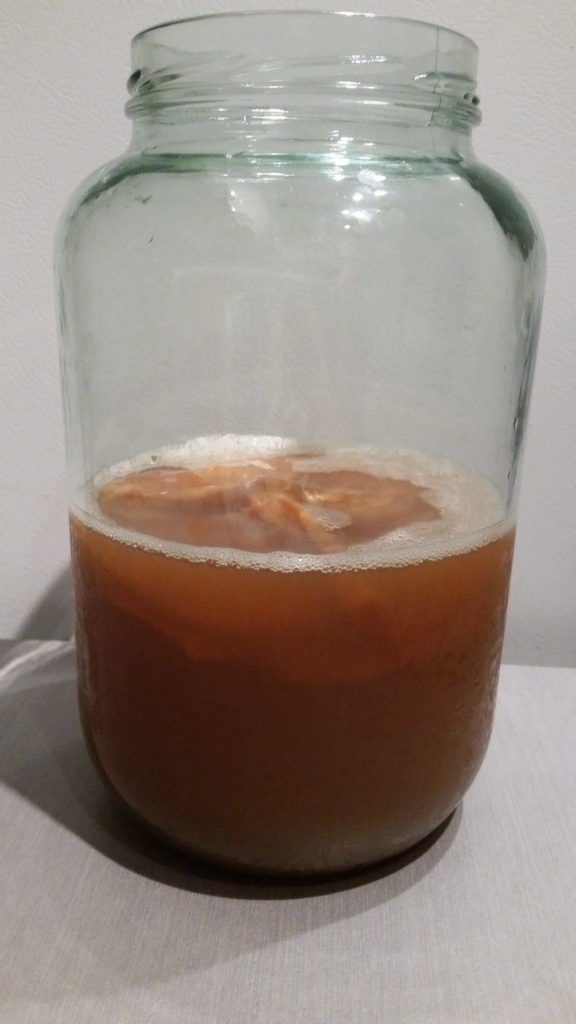
- Boil water and sugar in a pot
- Remove pot from the hot burner and add tea bags (let steep for 15 minutes)
- Remove tea bags, let brewed tea cool to room temperature
- Carefully transfer to glass jar or ceramic pot for fermenting
Step Two – Fermenting
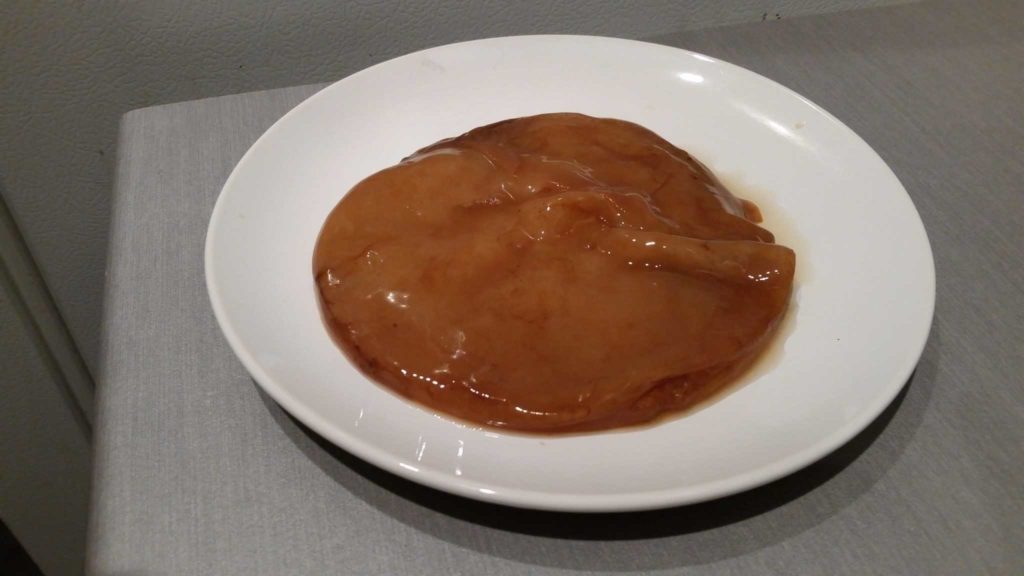
- Add your Scoby plus ½ cup Kombucha from previous batch to the sweetened brewed tea
- Cover with a clean cloth (or coffee filter) and put in a room temperature place
- Taste after 3 days. It will be a bit sour. Fermentation is sped up if the environment is warmer
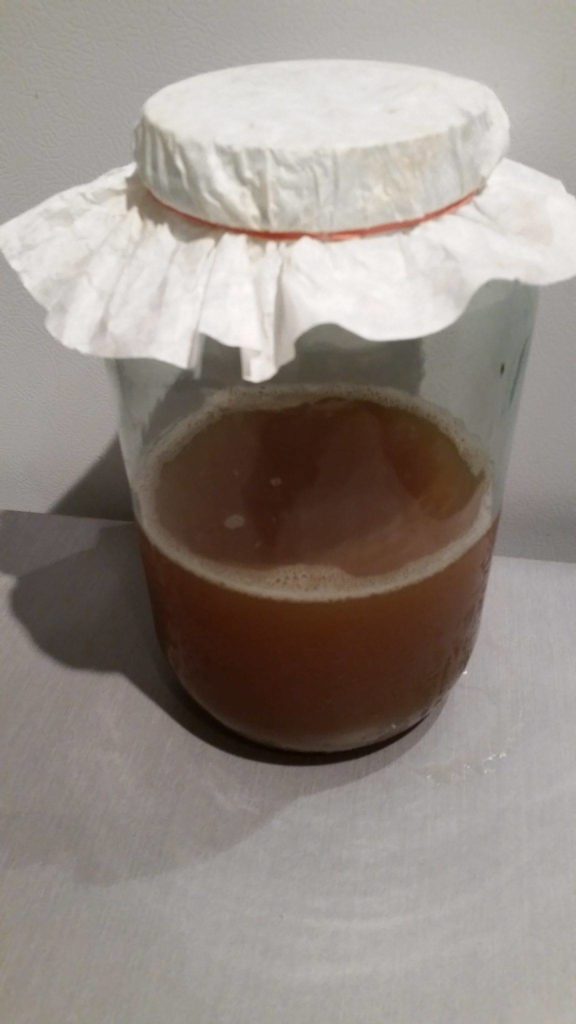
When is the Kombucha done?
This is a matter of preference. Some people like it almost like vinegar, others prefer it younger and sweeter. Kombucha that is fermented for 8-10 days has “digested” all of the sugar from the batch – making it optimal for health.
What is floating around in the Kombucha?
As fermentation continues, you may see brown strains floating around in the Kombucha; these strains have detached from the “mother”. Some people like to drink them and others prefer to strain them out.
Step Three – Bottling
When you are satisfied with the fermentation of your Kombucha, carefully remove the “mother”and “baby” SCOBY and place them in a separate mason jar for storage. Remember to save ½ cup of this batch for next time.
Using a sieve and a filter, transfer your Kombucha into a clean, closeable glass container. Once bottled, you can leave the container on the counter for a few days to create a fizzier brew. To stop the fermentation process, store your bottles of Kombucha in the refrigerator.
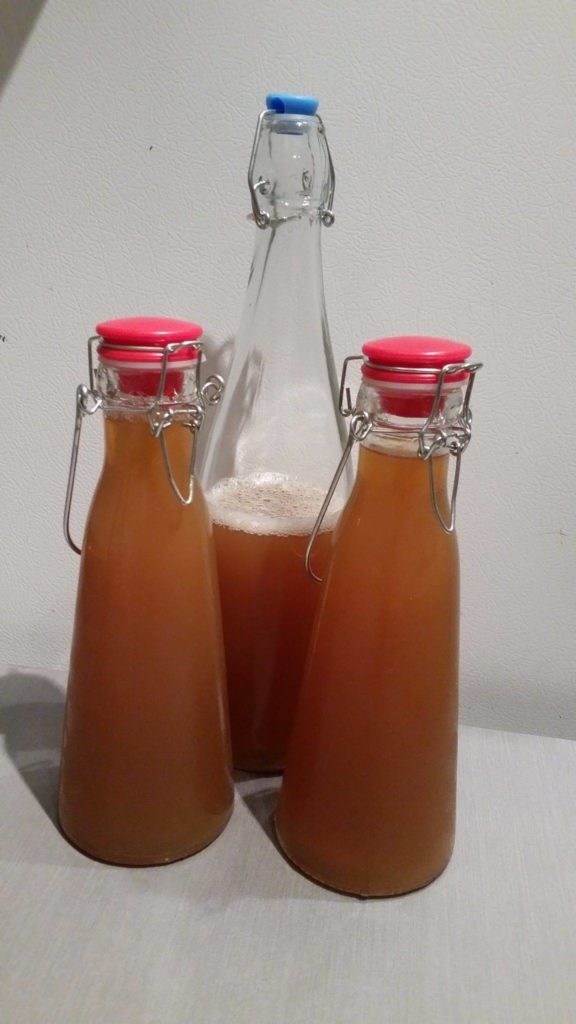
Caring for your SCOBY
When your SCOBY is not actively fermenting a batch of Kombucha, just store her in some liquid from the previous batch in a jar, loosely closed, in the fridge.
I hope you’ve enjoyed Alexa’s Kombucha brewing secrets and we hope you give it a go yourself! Let us know how you go in the comments below. And send us picture’s of your final brews 🙂
[recipe_widget]
Sources:
- Ginaldi, Lia, Maria Cristina Di Benedetto, and Massimo De Martinis. “Osteoporosis, Inflammation and Ageing.” Immunity & ageing : I & A 2 (2005): 14. PMC. Web. 23 Aug. 2016.
- Jayabalan, R., Malbaša, R. V., Lončar, E. S., Vitas, J. S. and Sathishkumar, M. (2014), A Review on Kombucha Tea—Microbiology, Composition, Fermentation, Beneficial Effects, Toxicity, and Tea Fungus. Comprehensive Reviews in Food Science and Food Safety, 13: 538–550. doi:10.1111/1541-4337.12073
- Jun Sun, Eugene B. Chang. Exploring gut microbes in human health and disease: Pushing the envelope. Genes & Diseases. Volume 1, Issue 2, December 2014, Pages 132–139
- Meyers, Jackie. Your Kombucha Guide: Discover A Safer, Cheaper, & Easy Ways To Make Your Own Unique Flavored Kombucha From Scratch! N.p.: Nisarg D Parekh, 2015. Web.





gloria miller
August 27, 2016 , 8:37 amIn the video, a bottle of kombucha explodes and shoots the fermenting liquid higher than the camera angle can show. Alexa laughs it off, and I’m glad she has a good sense of humor about it. However, as a senior citizen, the thought of having my kitchen ceiling, walls, counters, cabinets, and floors liberally sprayed with kombucha is rather daunting. I’d have to hire somebody to wash it all down. Realistically, why would I want to follow Alexa’s lead and take a chance on having that happen? Surely she is doing something wrong. …